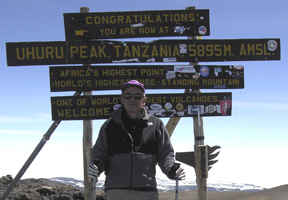|
Profiles: News about people from AGI and its 44 member societies
Archive of past Society Page/Profiles stories by date
H. Jay Zwally: Glaciologist by chance
 On
one of his almost yearly trips to the Greenland ice sheet, Jay Zwally
nearly drove his unreliable snowmobile into the Atlantic Ocean.
On
one of his almost yearly trips to the Greenland ice sheet, Jay Zwally
nearly drove his unreliable snowmobile into the Atlantic Ocean.
“I was out by myself in a snowmobile, putting in poles, making GPS measurements,” the 60-plus-year-old glaciologist says, on a snowmobile that was hard to start. So, with the throttle in one hand and a short rope in the other to turn over the engine, Zwally jerry-rigged the machine — which started without him on it. “The snowmobile took off toward the coast, with the sled behind it,” Zwally says. “My first thought was, ‘How in the world am I ever going to explain this to Koni?’”
H. Jay Zwally does most of his fieldwork in Greenland, but the groundbreaking glaciologist has also gone to Mount Kilimanjaro to field check satellite data measuring ice around the planet. Photo is by Konrad Steffen.
Koni is Zwally’s colleague Konrad Steffen, who established Swiss Camp on the Greenland ice sheet, the site where, in 1996, Zwally started logging GPS measurements every 10 days that recorded the motion of the Greenland ice sheet throughout the year. The data led to a landmark Science paper in 2002 that showed that the edges of the sheet accelerate in the summer months, when melting is greatest.
For a long time, “we knew that water got to the bottom of glaciers,” says Waleed Abdalati, head of the Cryospheric Sciences Branch at NASA’s Goddard Space Flight Center in Greenbelt, Md. By filling crevasses and prying them open by freezing and thawing, water finally reaches the land beneath, where it can grease the skids, so to speak, speeding up glacier flow. “What nobody knew is that this happens on a thick ice sheet,” Abdalati says, where crevasse structures are different. “People thought [the water] would freeze before it got to the bottom.” But years of careful satellite measurements paid off for Zwally, showing the same glacier acceleration effect applies to huge ice sheets, in what is now unofficially known as the Zwally effect.
The title both embarrasses and pleases the ice scientist, who was trained as an aeronautical engineer and atomic and molecular physicist. In assessing how he has become one of the leaders in the glaciology community, Zwally says that he “got lucky,” starting off as a young program manager for the National Science Foundation (NSF) polar programs in 1972.
While a student on a NASA fellowship, pursuing physics and engineering at the University of Maryland in College Park, Zwally designed a key part of a solar wind detector for one of NASA’s Explorer missions. After earning his Ph.D. in 1968, he found himself looking for work at a time that physics funding had taken a nosedive, and he continued in a grant-funded research position at the university for three years. When the NSF position opened, polar programs head Joe Fletcher was “looking for somebody who knew something about remote sensing and technology,” Zwally says, “and so I got offered the job, largely on my technical expertise.”
In 1974, Zwally returned to NASA, where he developed a cryosphere research program. He also led the development of ICESat, a polar-orbiting satellite observatory that got off the ground in 2003 (under his watch since 1979). His work at NASA led to a groundbreaking 1989 paper that used satellite altimetry data to show changing elevations and volumes for the Greenland ice sheet. But “in Jay’s case, it wasn’t just enough to look at it from space,” says Abdalati, his former post-doc and now his supervisor; he wanted to go look in the field, to see the links between ground and space observations.
In 1994, Zwally got into the field in Greenland with Steffen, a climatologist at the University of Colorado in Boulder. He “actually started as a helper on our camp, even though he’s a senior researcher,” Steffen says, joking that he called Zwally “my first snowblower man.” Since then, “we have been in the field together every year,” says Steffen, who has accompanied Zwally to Mount Kilimanjaro to field check satellite data there.
Zwally’s most recent publication (with co-workers in the December Journal of Glaciology) has kicked up a little controversy, Abdalati says, taking a long view on data showing that the Greenland ice sheet actually grew slightly between 1992 and 2002, while other data analyses indicate shrinking of the Greenland and Antarctic ice sheets. “He’s careful and thorough,” considering potential errors carefully and establishing his assumptions clearly, Abdalati says. “A number of people might disagree with his final conclusion, but there’s no question as to how he gets there.”
Zwally eventually did tell Steffen about the incident of the snowmobile, which drove off about 150 meters before the strap came loose, bringing the machine to a sputtering stop. While the researchers were relaxing at camp the night of the incident (eating Zwally’s lauded sushi, drinking and preparing to get into the sauna that Steffen says Zwally built, or rather, graduate students built under his supervision), Zwally started to laugh without any seeming provocation.
Finally, the glaciologist told his colleagues about the entire episode, which Russell Huff, a former graduate student, named Zwally’s folly. “It was too good not to be told,” Zwally says, with a mix of good humor and embarrassment.
Naomi Lubick
Geotimes contributing writer

 Subscribe
Subscribe

